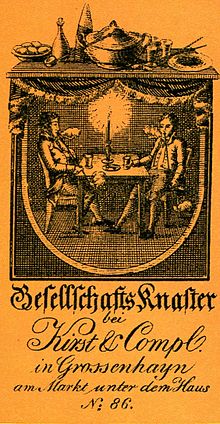Knaster
Knaster describes a tobacco in colloquial German . Today every kind of smokable plant parts (except tobacco) is considered in the youth and scene language as a knaster .
In the 18th to the beginning of the 20th century, a morose man was also called a jailer. Regionally, a knaster is also a (former) prisoner .
Concept history
tobacco
At the time of the first evidence at the beginning of the 17th century, the word referred to a spicy, mild tobacco of high quality that was transported in pipe baskets ( Spanish canastros , Greek kánastron ). There was talk of Canastertobac what to Canaster / Kanaster and then vocal failure to Knaster was shortened and probably in this form over the Netherlands in the German language borrowed was. The word knaster only received a derogatory connotation in student language, which has become generalized.
Hemp flowers
In the 18th, 19th and early 20th centuries, the flowers of the commercial hemp used in the production of fibers (hemp ropes) were called Knaster in German-speaking countries . The flowers were smoked in a pipe . The THC content of such useful hemp varieties is far lower than that of the intoxicating hemp varieties in use today . Perhaps the word is Knaster onomatopoeic from the noise of the bursting of the seed hemp smoking.
Herbal mixture
Knaster has been a Europe-wide protected brand since 1996 and denotes a product series of herbal mixtures for room air improvement. Like the herb chain , they are not sold as tobacco products , but have been subject to tobacco tax and the food law since June 20, 2007 . These mixtures are tobacco and nicotine free and are often smoked in practice.
The smoke from crackers contains a comparable amount of tar and carcinogenic substances such as polycyclic aromatic hydrocarbons (PAH). In addition, harmful fine dust and carbon dioxide are produced , which is why Knaster cannot be considered to be safe smoking. Many consumers use nicotine-free cigarettes to break away from their tobacco addiction.
Sullen man
Since the 18th century a morose, grumpy old man was also referred to as Knaster . Earlier in the 17th century even as Knasterer or Knasterbart named, this term describes onomatopoeic (see also crackle ) dark sound impressions as growl , grumble or growl and so the verb was knastern finally in the sense of morose be used and Knaster a substantive.
Teacher lamp
This literary figure in Max and Moritz plays a role in the 4th trick. He's a jail lover. Black powder is poured into the pipe , causing an explosion.
See also
Web links
Individual evidence
- ↑ ( Kluge 2002 ), keyword Knaster .
- ↑ Quan Gan, Jie Yang, Gonghuan Yang, Maciej Goniewicz, Neal L. Benowitz: Chinese “Herbal” Cigarettes Are as Carcinogenic and Addictive as Regular Cigarettes . In: Cancer Epidemiology and Prevention Biomarkers . tape 18 , no. 12 , December 1, 2009, ISSN 1055-9965 , p. 3497-3501 , doi : 10.1158 / 1055-9965.EPI-09-0620 , PMID 19959701 ( aacrjournals.org [accessed August 13, 2020]).
- ↑ Jong Ho Bak, Seung Min Lee, Heung Bin Lim: Safety Assessment of Mainstream Smoke of Herbal Cigarette . In: Toxicological Research . tape 31 , no. 1 , March 2015, ISSN 1976-8257 , p. 41-48 , doi : 10.5487 / TR.2015.31.1.041 , PMID 25874032 , PMC 4395654 (free full text).

